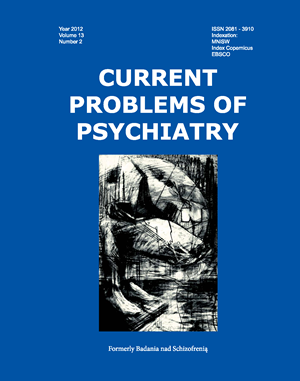Obraz siebie a ocena jakości życia u pacjentówz uszkodzonym stawem kolanowym
Słowa kluczowe:
niestabilność kolana, więzadło krzyżowe przednie, uszkodzenie łąkotki, niewydolność czynnościowa kolana, bóle przedniego przedziału kolana, dysfunkcje rzepkowo-udowe, obraz siebieAbstrakt
Obraz siebie oznacza zorganizowany zespół cech, które jednostka nauczyła się uznawać za własne, pełniący funkcje integracji i stabilizacji osobowości.
Celem pracy było udzielenie odpowiedzi na następujące problemy badawcze:
- czy i jakie zależności występują między cechami obrazu siebie a czasem trwania choroby u pacjentów z uszkodzeniem stawu kolanowego?
- czy i jakie zależności występują między obrazem siebie a oceną jakości życia oraz stopniem ograniczenia aktywności w zakresie pracy zawodowej i relacji społecznych u pacjentów z uszkodzeniem stawu kolanowego?
Grupa badana. Badaniami objęto 32 pacjentów (15 kobiet i 17 mężczyzn), hospitalizowanych w NZOZ Arthros w Nałęczowie z powodu uszkodzeń stawów kolanowych. Średni wiek badanych wynosił 31 lat. Wskazaniem do leczenia u 17 pacjentów była niestabilność kolana z powodu uszkodzenia więzadeł krzyżowych, u 3 zespół bocznego przyparcia rzepki, u 2 chorych nawykowe zwichnięcie rzepki, u 8 uszkodzenie łąkotki, a 1 osoba doznała śródstawowego złamania kolana. Średni czas trwania niesprawności wynosił 5 lat. Przed operacją z różnych form rehabilitacji i farmakoterapii korzystało 7 osób.
Metody. W pracy zastosowano: Test Przymiotnikowy ACL, Gougha i Heilbruna, w wersji „jaki jesteś?” oraz Ankietę własnej konstrukcji, na podstawie której uzyskano dane socjodemograficzne oraz informacje dotyczące: czasu trwania choroby, oceny wpływu choroby na jakość życia, pracę zawodową, relacje społeczne i hobby. Pacjenci wypełniali wymienione kwestionariusze w ciągu pierwszych dwóch dni po operacji.
Wyniki i wnioski.
Dłuższy okres trwania choroby u pacjentów z uszkodzeniem stawu kolanowego współwystępuje z nasiloną potrzebą stabilizacji, bezpieczeństwa, unikaniem sytuacji konfliktowych, nasiloną samokontrolą, ograniczeniem relacji społecznych oraz brakiem zaufania do siebie i innych ludzi.
Im bardziej pacjenci z uszkodzeniem stawu kolanowego oceniają, że choroba pogorszyła ich jakość życia oraz ograniczyła ich pracę i relacje społeczne, tym większa charakteryzuje ich zależność, potrzeba poszukiwania bezpieczeństwa, brak spontaniczności, nasilony pesymizm, nadmierna samokontrola, ucieczka przed rzeczywistością w marzenia oraz tendencja do idealizowania siebie.
Bibliografia
1. Siek S. Formowanie osobowości. ATK; Warszawa: 1986.
2. Reykowski J. Osobowość jako centralny system regulacji i integracji czynności człowieka. W: Tomaszewski T. (red.): Psychologia. PWN; Warszawa: 1978, s. 762-826.
3. Reykowski J. Osobowość a społeczne zachowanie się ludzi. PWN; Warszawa: 1976.
4. Strelau J. (red.) Psychologia. Podręcznik akademicki. Tom 2. Psychologia ogólna. GWP; Gdańsk: 2000.
5. Czabała Cz. Czynniki leczące w psychoterapii. PWN; Warszawa: 1997.
6. Jarosz M. (red.), Psychologia lekarska. PZWL; Warszawa: 1983.
7. Pawłowska B., Papuć E. Obraz siebie w okresie rzutu i remisji w postaci zaostrzająco-zwalniającej stwardnienia rozsianego (RR-MS). Ann. UMCS Sect. D, 2004; 59 supl. 14 [cz.] 4: 334-338.
8. Chuchra M. Rodzina z dorosłym dzieckiem chorym na schizofrenię. Porównawcze studium koncepcji siebie i innych. Rozprawa habilitacyjna. Wydawnictwo KUL; Lublin: 2010.
9. Krueger G., Koo J, Lebwohl M, Menter A., Stern R.S., Rolstad T. The impact of psoriasis on quality of life: results of a 1998 National Psoriasis Foundation patient-membership survey. Arch. Dermatol., 2001; 137 (3): 280-284.
10. Pawłowska B., Papuć E., Opolska A., Witczak W. Poziom lęku a obraz siebie u osób z chorobą niedokrwienną serca. Psychiatr. Pol., 2006; 40(6): 1069-1079.
11. Weiss M.R. Psychological Aspects of Sport-Injury Rehabilitation: A Developmental Perspective. J. Athl. Train., 2003; 38(2): 172-175.
12. Kartus J., Magnusson L., Stener S., Brandsson S., Eriksson B.I., Karlsson J. Complications following arthroscopic anterior cruciate ligament reconstruction. A 2-5-year follow-up of 604 patients with special emphasis on anterior knee pain. Knee Surg. Sports Traumatol. Arthrosc., 1999; 7: 2-8.
13. Fithian D.C., Paxton L.W., Goltz D.H. Fate of the anterior cruciate ligament injured knee. Orthop. Clin. N. Am., 2002; 33: 621-636.
14. Wojtys E.M., Huston L.J., Taylor .PD., Bastian S.D. Neuromuscular adaptations in isokinetic, isotonic, and agility training programs. Am. J. Sports Med., 1996: 24; 187-192.
15. Arangio G.A., Chen C., Kalady M., Reed J.F. III. Thigh muscle size and strength after anterior cruciate ligament reconstruction and rehabilitation. J. Orthop. Sports Phys. Ther., 1997; 26: 238-243.
16. Carter T.R., Edinger S. Isokinetic evaluation of anterior cruciate ligament reconstruction: hamstring versus patellar tendon. Arthroscopy, 1999; 15: 169-172.
17. Pfeifer K., Banzer W. Motor performance in different dynamic tests in knee rehabilitation. Scand. J. Med. Sci. Sports, 1999; 9: 19-27.
18. Hiemstra L.A., Webber S., MacDonald P.B., Kriellaars D.J. Knee strength deficits after hamstring tendon and patellar tendon anterior cruciate ligament reconstruction. Med. Sci. Sports Exerc., 2000; 32: 1472-1479.
19. Brandsson S., Faxén E., Kartus J., Jerre R., Eriksson B.I., Karlsson J. A prospective four-to seven-year follow-up after arthroscopic anterior cruciate ligament reconstruction. Scand. J. Med. Sci. Sports, 2001; 11: 23-27.
20. Solomonow M., Krogsgaard M. Sensorimotor control of knee stability. A review. Scand. J. Med. Sci. Sports, 2001; 11: 64-80.
21. Crossman J. Coping with sports injuries: psychological strategies for rehabilitation. New York: Oxford University Press; 2001.
22. Juros A., Oleś P. Struktura czynnikowa i skupieniowa Testu Przymiotnikowego ACL H.G. Gougha i A.B. Helbruna. W: Brzeziński J., Hornowska E. (red.), Z psychometrycznych problemów diagnostyki psychologicznej. Wydawnictwo Naukowe Uniwersytetu im. A. M


